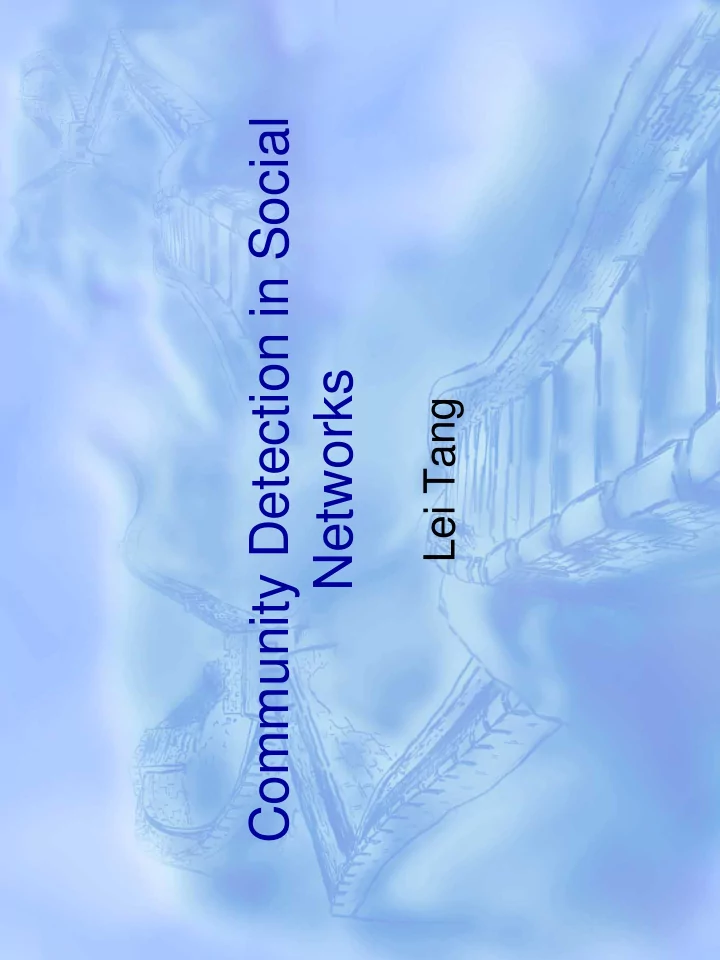

Community Detection in Social Networks Lei Tang
Properties of Complex Network Power Law Community Structure Small World
Why Community Detection? � Communities in a citation network might represent related papers on a single topic; � Communities on the web might represent pages of related topics; � Community can be considered as a summary of the whole network thus easy to visualize and understand. � Sometimes, community can reveal the properties without releasing the individual privacy information.
Community Detection, Reinventing the wheel?
Community Detection = Clustering? � As I understand, community detection is essentially clustering. � But why so many works on Community Detection? (in physical review, KDD, WWW) � The network data pose challenges to classical clustering method.
Difference � Clustering works on the distance or similarity matrix (k- means, hierarchical clustering, spectral clustering) � Network data tends to be “discrete”, leading to algorithms using the graph property directly (k-clique, quasi-clique, vertex-betweenness, edge-betweeness etc.) � Real-world network is large scale! Sometimes, even n^2 in unbearable for efficiency or space (local/distributed clustering, network approximation, sampling method)
Outline � Two recent community detection methods � Clustering based on shortest-path betweenness � Clustering based on network modularity
Basic Idea � A simple divisive strategy: � Repeat 1. Find out one “inter-community” edge 2. Remove the edge 3. Check if there’s any disconnected components (which corresponds to a community)
How to measure “inter-community” � If two communities are joined by a few inter-community edges, then all the paths from one community to another must pass the edges. � Various measures: � Edge Betweenness: find the shortest paths between all pairs of nodes and count how many run along each edge. � Random Walk betweenness. � Current-flow betweenness
Shortest-path betweenness � Computation could be expensive: calculating the shortest path between one pair is O(m), and there are O(n^2) pairs. � Could be optimized to O(mn) � Simple case: only one shortest path When there is only one single path between the Source S and other vertex, then those paths form a tree. Bottom-up: start from the leaves, assign edges to 1. Count of parent edge = sum (count of children edge)+1
Multiple shortest path � First compute the number of paths from source to other vertex � Then assign a proper weight for the path counts � sum of the betweenness =.number of reachable vertices.
Calculate #shortest path 1.Initial distance W:Number of shortest paths
Edge weight Update edge weight
Time Complexity � O(mn) in each iteration. � Could be accelerated by noting that only the nodes in the connected component would be affected. � Some other techniques developed: sampling strategy to approximate the betweenness; use specific network index for speed.
Obtain a hierarchical tree, use modularity To determine the number of clusters.
Modularity � Spectral clustering essentially tries to minimize the number edges between groups. � Modularity consider the number edges which is smaller than expected . � If the difference is significantly large, there’s a community structure inside. � The larger, the better.
Quiz � Given a network of m edges, for two nodes with degree k i , k j , what is the expected edges between these two nodes?
Modularity Calculation � Modularity can be used to determine the number of clusters, why not maximize it directly? � Unfortunately, it’s NP-hard �
Relaxation Eigen Value Problem! Modularity Matrix Beta i is the eigen value of the Eigen vector u i of modularity matrix B
Properties of Modularity Matrix � � (1,1,…1) is an eigen vector with zero eigen value. � Different from graph Laplacian, the eigen value of modularity matrix could be +, 0 or -. � What if the maximum eigen value is zero? � Essentially, it hints that there’s no strong community pattern. Not necessary to split the network, which is a nice property.
� Here, the spectral partitioning is forced to split the network into approximately equal- size clusters.
Extensions � Divisive clustering � K - partitioning…
Comments � I thought spectral clustering is the end of clustering. But here a new measure Modularity is proposed and found to be working very well, which confirms that “research is endless”, or “no last bug”. � Since Graph Laplacian and Modularity matrix both boils down to a eigen value problem, is there any innate connection between these two measures? � How could it work if we apply it directly to some classic data representation? � Extend modularity to relational data could be a promising direction. � There could be more opportunities than “wheels” in social computing. � Scalability is really a big issue.
References � M.E.J.Newman, Finding community structure in networks using the eigenvectors of matrices, Phys. Rev. , 2006 � M. E. J. Newman, M. Girvan , Finding and evaluating community structure in networks , Phys. Rev. 2004
Recommend
More recommend